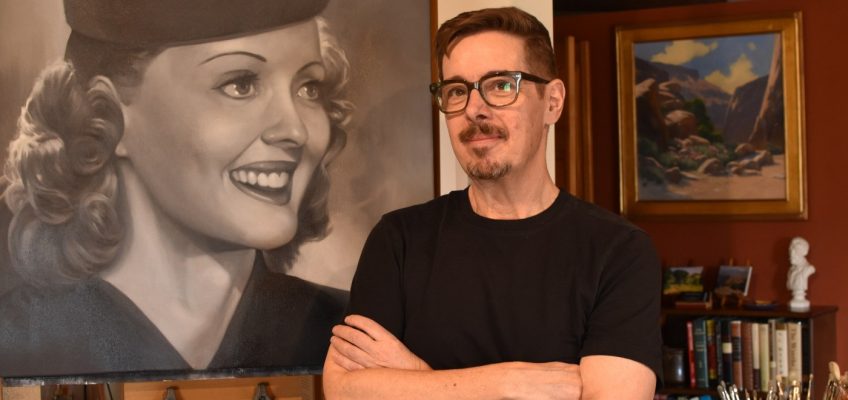When oil painter Richard Abraham was growing up on Michigan’s Upper Peninsula, he’d spend time in his local library’s art section.
Books on illustration and painting, he recalled, were right next to the section containing books about movies. As he worked his way through the shelves, he was struck by moody, mysterious stills of classic film actors like James Cagney and Greta Garbo.
At the time, he assumed he’d never actually watch many of the movies themselves; this was before VHS tapes were widely available, he said, and certainly before digital restoration techniques that now help old films look and sound better than they have in decades. But even as Abraham’s interests led him in other directions — including his mid-life career change about 25 years ago toward oil painting — he was still fascinated by Hollywood’s Golden Age.
Three paintings by Lowertown artist Richard Abraham hang at Lost Fox on April 8, 2025. The works depict, from right to left, mid-century actors Robert Mitchum, Anita Ekberg and Peter Lorre. (Jared Kaufman / Pioneer Press)
Emotional, close-up portraits of vintage movie actors comprise Abraham’s current exhibition, “Framing Film: Painting Cinema’s Shadows,” on view through the end of the month at Lost Fox, the Lowertown cafe at 213 E. 4th St., just a few blocks from Abraham’s loft studio.
When Abraham decided to move to the Twin Cities and become a painter in the late ’90s, he pursued a classical path in visual arts, studying oil painting and focusing on traditional subjects like still life and outdoor landscapes. He’s won plenty of awards for this work and regularly teaches classes in his studio, too.
And meanwhile, he has watched and rewatched dozens of the vintage films that once eluded him. Especially during the early pandemic, he said, black-and-white movies from the 1920s and ’30s became his “comfort food.”
The current old-Hollywood series was initially a personal pet project during that time period, he said, but he came to realize that, in depicting “these sweaty, desperate, film noir types,” he was able to convey the same sense of restrained drama and emotional resonance that characterizes his other work.
“I went away from just, ‘Oh, that’s a nice shot of Bette Davis’ to something where it feels like there’s consequences in the painting,” he said.
When Abraham is planning a painting, he’ll first watch the inspiration film a number of times, taking notes on well-composed scenes. He’ll then narrow down a list of a dozen or so still-frame shots before choosing his ultimate subject. The best frames to paint, he finds, are ones where harsh lighting creates deep contrasts, especially in faces — a visual sense of tension, secrecy, high stakes.
“It’s all about value, about depth, and finding images that accentuate that; that have a lot of shadow play on the face, so you have something to sink into,” he said. “And when it’s going well, you can really get lost in it. Like Robert Mitchum’s trenchcoat becomes its own world. You’re just in all the valleys and the buttons and the reflected light and deep shadows.”
(Interestingly, he said, male actors are more commonly shown this way than women, even in equally emotionally pivotal moments. Hard lighting and tight zoom accentuates facial wrinkles and creases, perhaps desirable for a rugged male character; women were more frequently shot in softer light or from wider angles to hide those features and appear glamorous.)
On view at Lost Fox is just a selection of the dozens of portraits Abraham has painted: There’s Giulietta Masina in “La Strada” and Anita Ekberg in “La Dolce Vita,” there’s Peter Lorre and Robert Ryan. He has about 20 more in the studio that didn’t make the show, including the first color portrait in the series — of Judy Garland in “The Wizard of Oz,” of course.
“One thing leads to another, and sometimes you can’t predict where that’s going to lead to and why,” he said. “You just follow it. I think you can drive yourself crazy justifying why you’re doing what, but I think just enthusiasm is justification enough. You follow what gets you excited to go to the easel.”
Related Articles
Made in St. Paul: A 20-foot geometric optical artwork, by custom cabinetry shop Designed & Made
Made in St. Paul: Ice skating as storytelling and Black cultural expression, by figure skater Deneane Richburg’s organization Brownbody
Made in St. Paul: Painter and wine educator Angela Kallsen finds the personalities of wine grape vines


Leave a Reply